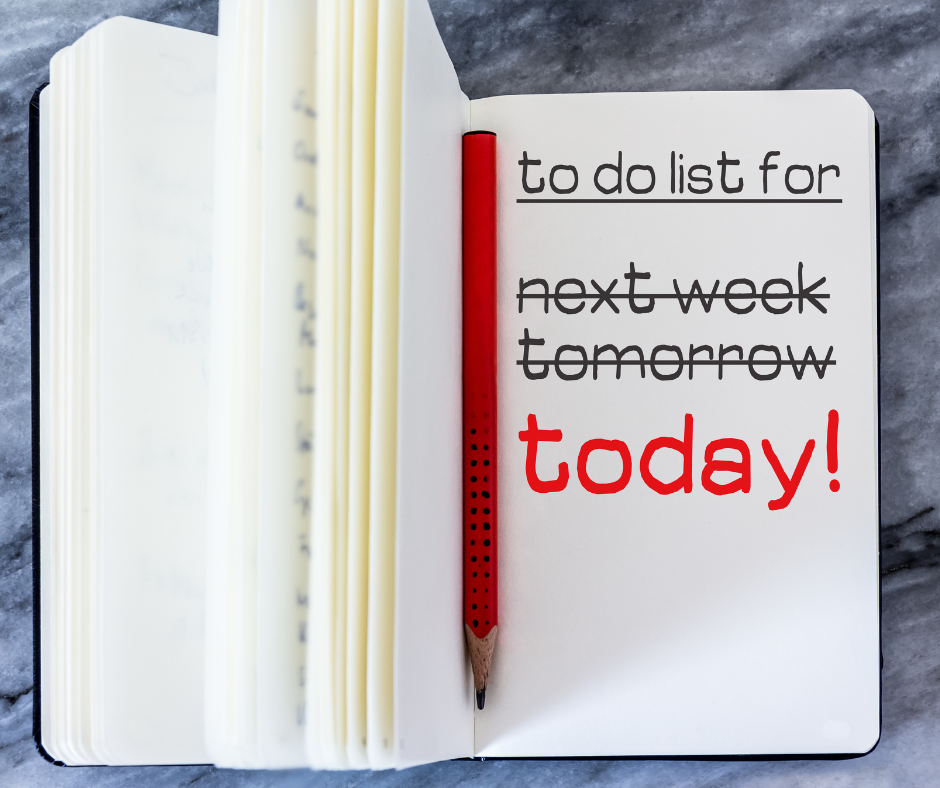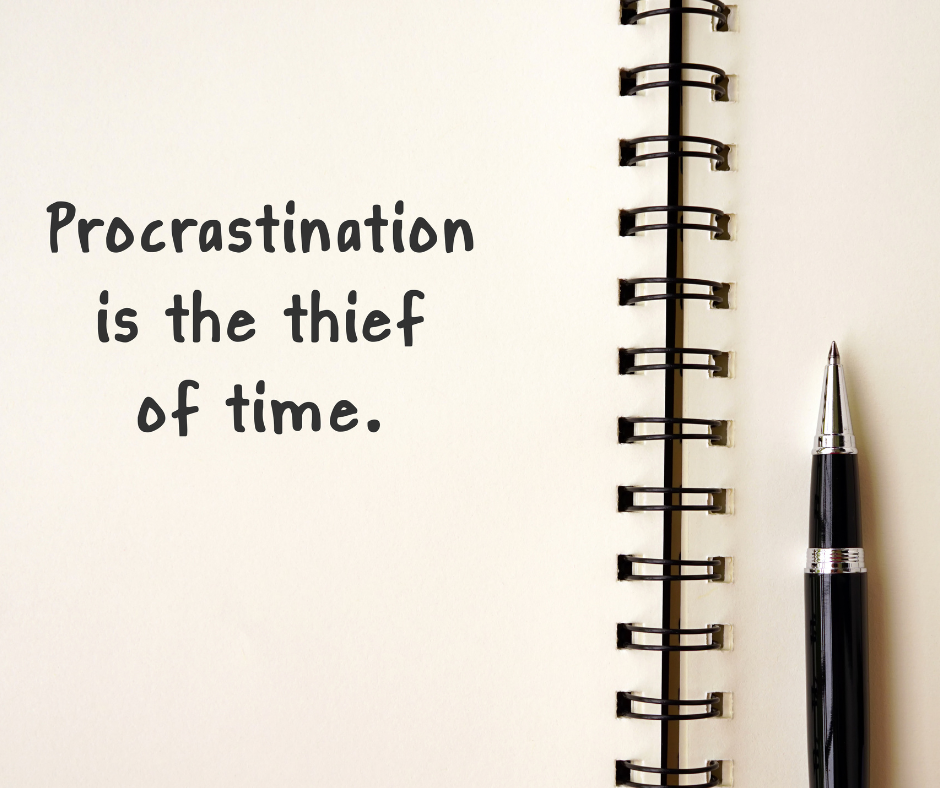“I Know What I Need to Do… So Why Can’t I Just Do It?”
A Therapist’s Guide to Motivation, Avoidance, and Actually Getting Things Done
We’ve all been there. The laundry sits unfolded for days. The email stays half-written. The task you’ve been “meaning to do” suddenly becomes the most intimidating thing on your to-do list. You know exactly what needs to happen — yet the gap between intention and action feels like a canyon.
You might start to wonder, What’s wrong with me? Why can’t I just do it like everyone else?
But here’s the truth: this struggle isn’t laziness. It’s often a mix of emotional overwhelm, perfectionism, executive dysfunction, and fear of failure. And learning how to move through it doesn’t start with forcing yourself to “just try harder.” It starts with understanding why this happens and how to gently rewire the cycle.
Let’s take a deep breath and break it down together.

The Psychology of “I’ll Do It Later”
Avoidance feels like a relief — at least for a moment. When you delay a task, your nervous system gets a tiny break from stress. You don’t have to face potential failure, criticism, or exhaustion yet. The problem is, that short-term relief becomes long-term anxiety.
This push-and-pull between avoidance and guilt creates what therapists call the avoidance loop:
- You feel anxious or overwhelmed by a task.
- You avoid it for temporary relief.
- Guilt and self-criticism build up.
- The task now feels even harder to face.
Sound familiar? You’re not broken — you’re human. The nervous system is wired to protect you from discomfort, even if it means sabotaging your plans. The goal isn’t to shame yourself out of the loop, but to disarm it with awareness and self-compassion.

Motivation Isn’t a Switch — It’s a System
Most people think motivation comes before action: I need to feel ready before I start.
In reality, it’s the other way around. Action creates motivation.
Once your brain experiences even the smallest success — like opening the document, making the call, or washing one dish — it releases dopamine, which makes it easier to keep going. The hardest part is the beginning, not the doing itself.
That’s why creating smaller, safer entry points into tasks matters so much. You don’t need a massive burst of energy. You just need enough momentum to start.
The Inner Critic vs. The Inner Coach
When you procrastinate, your inner critic tends to take the mic:
“You’re so lazy.”
“Other people don’t struggle with this.”
“You’re wasting time again.”
But shame never leads to progress — it only paralyzes. What actually helps is curiosity:
“What’s making this task feel heavy right now?”
“Is there fear here — or just fatigue?”
“What small thing could make this easier?”
The moment you shift from judgment to gentle inquiry, your nervous system relaxes, and the task becomes less threatening.

Why “All-or-Nothing” Thinking Keeps You Stuck
Many people avoid tasks because they believe it’s “all or nothing”:
- If I can’t finish it perfectly, I won’t start it at all.
- If I can’t clean the whole room, what’s the point of doing one corner?
But progress doesn’t happen in huge leaps — it happens in inches. The goal isn’t perfection. It’s traction. You’re not failing if you only do 10% today. You’re moving forward. And that’s enough.
10 Therapist-Approved Ways to Get Things Done (Without Burning Out)
These aren’t “grind harder” tips — they’re compassionate, nervous-system-friendly ways to help your brain actually want to do the work again.

1. Start With the 2-Minute Rule
The brain often resists tasks that feel huge or undefined. The 2-minute rule is about sneaking past that resistance by starting so small it feels almost silly. Tell yourself you’ll just spend two minutes on something — and once you begin, your brain often keeps the momentum going because the hardest part, starting, is already done. This method builds trust with yourself: you’re not forcing productivity, you’re inviting it gently. Over time, those two-minute starts train your nervous system to feel safe taking action instead of freezing.
Try this:
- Open the email app and read just one message — no replies needed yet.
- Put one dish in the sink or fold one shirt.
- Write one sentence or open the document you’ve been avoiding.
2. Name What’s Actually Hard About It
When we avoid something, it’s rarely because we’re lazy — it’s because something about the task feels emotionally heavy. Maybe it triggers self-doubt, perfectionism, or fear of failure. Naming what’s actually difficult gives your emotions a seat at the table and reduces their control over you. Once you identify the true barrier — “I don’t know where to start” or “I’m scared I’ll mess it up” — you can tailor your approach with compassion instead of criticism. Clarity creates movement.
Ask yourself:
- “Am I avoiding confusion, fear, or boredom?”
- “Would this feel easier if someone explained it or broke it down with me?”
- “Is this task connected to a deeper fear, like disappointing someone or not being good enough?”

3. Pair It With Something Pleasant
Your environment has more influence than your willpower. Pairing an unpleasant task with something sensory or enjoyable helps your nervous system stay regulated instead of overwhelmed. This technique — called behavioral bundling — helps your brain associate productivity with comfort, not punishment. The goal isn’t to distract yourself, but to make the moment feel safe enough to begin.
Examples:
- Play your favorite playlist or an upbeat podcast while cleaning or emailing.
- Light a candle or open a window for fresh air to signal a gentle transition into “focus mode.”
- Sip a cozy drink or snack while working on something stressful.
4. Lower the Bar — For Real
Perfectionism kills momentum. When you believe every task has to be done perfectly, you never let yourself start. The antidote? Lower the bar — way down. “Half-done” is better than “not done,” and progress counts even when it’s messy. When you lower the bar, you teach your brain that showing up is more important than doing it flawlessly. It’s about moving gently toward consistency instead of chasing impossible standards.
Try this:
- Write a messy draft and promise you won’t edit until later.
- Clean one area instead of the whole house — one drawer, one corner, one counter.
- Finish “good enough” instead of perfect and notice how freeing it feels.

5. Externalize Accountability
Humans are social creatures — we regulate through connection. If motivating yourself alone feels impossible, borrow someone else’s energy for a while. This isn’t weakness; it’s co-regulation. External accountability can look like small check-ins, shared progress, or even silent virtual work sessions. Sometimes, we just need to feel seen to start moving again.
Examples:
- Text a friend, “I’m going to tidy for 15 minutes — check in with me in half an hour.”
- Try a “body doubling” session: log onto Zoom with someone else while each of you works on your own task.
- Schedule your work session in a coffee shop so you feel naturally more alert and accountable.
6. Break the Task Into Emotional Stages
To-do lists focus on what you need to do, but they miss how it feels to do it. Try creating an emotional checklist that honors every stage of the process — from dread to pride. By naming your emotional progress, you validate effort, not just completion. This helps you stay compassionate toward yourself when motivation wavers and turns productivity into something emotionally informed, not mechanical.
Try this emotional sequence:
- “I’m resisting it right now — and that’s okay.”
- “I’m thinking about starting — that’s still progress.”
- “I began and did part of it — I can be proud of that.”

7. Use Micro-Starts to Build Momentum
Sometimes, all you need is to open the loop. You don’t have to finish the task — you just need to take the tiniest possible step that makes the next step easier. Micro-starts reduce overwhelm and shift your brain from avoidance mode to engagement mode. You’re creating momentum one micro-action at a time, and soon, the bigger task feels less intimidating.
Examples:
- Open your laptop and title your document — then walk away for a minute.
- Put one load of laundry in the machine — don’t fold yet.
- Open the project, bookmark the section you’ll start with, and stop there for now.
8. Reward, Don’t Punish
If every task ends in self-criticism (“I should’ve done more”), your brain will begin associating productivity with pain. Instead, link effort with positive reinforcement — even small rewards. This strengthens your dopamine pathways and encourages your brain to repeat that behavior. Celebrate consistency, not just outcomes.
Reward yourself by:
- Watching a favorite show guilt-free after finishing something small.
- Texting a friend, “I finally did it!” to get a social dopamine boost.
- Taking a short walk or stretch break as a “thank you” to your body for showing up.

9. Adjust Your Environment for Success
Your space should work with you, not against you. Visual clutter increases mental clutter, and simple environmental tweaks can change everything. When tasks are physically accessible and cues are visible, it’s easier to start. Design your space to reduce friction and invite ease.
Examples:
- Keep frequently used items (like notebooks or laundry detergent) where you actually use them.
- Prep your workspace the night before so you can start the day with clarity.
- Use sticky notes or calendar alerts as compassionate visual nudges, not guilt reminders.
10. Use Compassionate Language
The way you talk to yourself shapes your emotional experience of effort. Harsh, demanding language triggers resistance; gentle, inviting language fosters cooperation. Replace “I have to” with “I choose to” or “I’m allowed to take a step toward this.” Words are nervous system cues — use them to create safety instead of fear.
Examples:
- Say, “I’m giving myself ten minutes to focus,” instead of “I must finish this now.”
- “I get to make this a little easier on myself,” instead of “I should’ve done this already.”
- “I’m starting where I am, not where I think I should be.”

When Pressure Feels Like the Only Way
If you grew up in an environment where love or approval was tied to achievement, rest and imperfection can feel unsafe. You might push yourself to exhaustion because it’s the only way you’ve ever known how to feel “enough.”
Healing means learning that you can be productive and kind to yourself. You can accomplish goals without harsh self-talk. You can rest without guilt.
This shift doesn’t make you less ambitious — it makes you sustainable.
Motivation Is Emotional, Not Moral
Getting things done isn’t about being “good” or “disciplined.” It’s about understanding your nervous system, emotional needs, and capacity on any given day.
Once you see that, you stop fighting yourself — and start collaborating with your body and mind.
You don’t have to overhaul your life to get unstuck. You just need to start small, stay gentle, and trust that doing enough is enough.

The KEY Takeaway 🌿
At KMA Therapy, we know that motivation is often tangled up in perfectionism, burnout, trauma, and shame — not laziness. Therapy can help you uncover what’s beneath your resistance, build emotional safety around productivity, and learn how to move forward without punishing yourself along the way.
If you’re ready to find balance between ambition and compassion — to feel proud of progress instead of pressured by it — we’d love to help you get there.
📖 Book a free 15-minute discovery call with one of our therapists today. Sometimes, getting unstuck begins with a single conversation.
Try This: A 5-Minute “Do the Thing” Reset 🌿
This short, mindful exercise is meant to help you shift from overwhelm to gentle momentum — especially when you’ve been putting something off or feeling stuck. You don’t need perfect motivation to try it — just curiosity.
Step 1: Name It
Take a deep breath and say (out loud or in your head):
👉 “The thing I want to do but keep avoiding is…”
Write it down if it helps. Naming it starts to make it less abstract and more doable.
Step 2: Feel It in Your Body
Notice what happens in your body as you think about that task. Do your shoulders tense? Does your stomach tighten? No judgment — just awareness.
Then, try placing one hand over your chest and take three slow, deep breaths, sending a quiet message of safety to your nervous system.
Step 3: Shrink It Down
Now ask yourself: What would it look like to start this for two minutes?
Examples:
- Open the notes app and title the project.
- Put one dish in the sink.
- Draft one sentence of an email.
That’s it — two minutes.
Step 4: Celebrate the Start
When you’ve done your two minutes, pause and notice:
✅ “I began.”
✅ “That counts.”
✅ “I’m building momentum.”
Give yourself a small reward — stretch, sip water, smile. Let your body feel what it’s like to take action with gentleness.
Step 5: Reflect
Before you close the page, ask:
💭 “What helped me move today?”
💭 “How can I make it feel this manageable again tomorrow?”
This exercise helps rewire your brain to associate tasks with safety, not pressure — and every time you practice it, you’re teaching yourself that small steps do lead to big changes.






